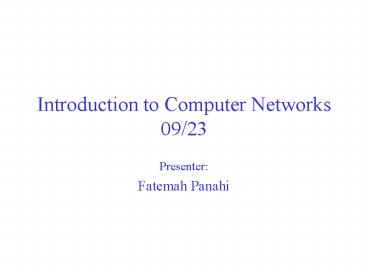Introduction to Computer Networks 09/23 - PowerPoint PPT Presentation
Title:
Introduction to Computer Networks 09/23
Description:
Introduction to Computer Networks 09/23 Presenter: Fatemah Panahi – PowerPoint PPT presentation
Number of Views:20
Avg rating:3.0/5.0
Title: Introduction to Computer Networks 09/23
1
Introduction to Computer Networks09/23
- Presenter
- Fatemah Panahi
2
Outline
- Client-Server code
- Project overview
- Review from last session
- Spanning Tree Algorithm
3
Review
- Shared medium vs. Point to point links
- Ethernet as a shared medium link
- LAN is a Local Area Network, Usually based on the
Ethernet technology - Ethernet limitation Cable length, Host number
4
Extending LANs
- Repeaters A device that forwards signals, just
like an amplifier - Hub A multi-way repeater Usually used when you
cannot attach a host directly to a thin cable. - No notion of frames
- Broadcast Everybody can get the message that
someone sends.
5
Bridges LAN switches
- Switch multi-input, multi-output device which
transfers packets from an input to one or more
outputs - Using repeaters to extend a LAN has its own
limits - Total number of repeaters
- Total length
- Alternative Have a node between 2 Ethernet
segments to forward frames - Isolates collision domains if used carefully
- Increases total bandwidth of the network
6
Learning Bridges
- It is inefficient to always broadcast message to
all Ethernet segments - How do we know on which port a host is?
- Manual table
- Learning mechanism
- Learning
- Inspect the source address of each frame
- Each table entry has a timeout
- Not sure what to do? Broadcast
7
Spanning Tree
- How to handle forwarding in complex Layer 2
topologies?
8
Each LAN segment can have many bridges
- More complex topologies can provide redundancy.
- But can also create loops.
- E.g. What happens when there is no table entry?
- Multiple copies of data
- ? Could crash the network ? has happened often!
host
host
host
host
host
host
Bridge
Bridge
host
host
host
host
host
host
9
What is a Spanning Tree?
- Reduce our topology graph to a tree
- Make sure there are no loops in the topology
- All LAN segments are still connected to the LAN
and can receive messages - Main idea Bridges choose the ports over which
they have to forward frames.
10
Spanning Tree Protocol Overview
- Embed a tree that provides a single unique
default path to each destination - Bridges designate ports over which they will or
will not forward frames - By removing ports, extended LAN is reduced to a
tree - Addresses the crashing problem but tree is not
resilient - When switch/link fails, rerun protocol to
converge to new tree
11
Spanning Tree Algorithm
- Root of the spanning tree is elected first ? the
bridge with the lowest identifier. - All ports are part of tree
- Each bridge finds shortest path to the root.
- Remembers port that is on the shortest path
- Used to forward packets
- Select for each LAN a designated bridge that will
forward frames to root - Has the shortest path to the root.
- Identifier as tie-breaker
12
Spanning Tree Algorithm
- Each node sends configuration message to all
neighbors. - Identifier of the sender
- Id of the presumed root
- Distance to the presumed root
- Initially each bridge thinks it is the root.
- B5 sends (B5, B5, 0)
- When B receive a message, it decide whether the
solution is better than their local solution. - A root with a lower identifier?
- Same root but lower distance?
- Same root, distance but sender has lower
identifier? - Message from bridge with smaller root ID
- Not root stop generating config messages, but
can forward - Message from bridge closer to root
- Not designated bridge stop sending any config
messages on the port
B3
B5
B7
B2
B1
B4
B6
13
Spanning Tree Algorithm
- Each bridge B can now select which of its ports
make up the spanning tree - Bs root port
- All ports for which B is the designated bridge on
the LAN - States for ports on bridges
- Forward state or blocked state, depending on
whether the port is part of the spanning tree - Root periodically sends configuration messages
and bridges forward them over LANs they are
responsible for - Any bridge failure gt Start over
14
Spanning Tree AlgorithmExample
- B3 receives (B2,B2,0)
- Since 2lt3 B3 accepts B2 as a root
- B3 adds one to the distance advertised by B2(0)
and thus sends (B3,B2,1) toward B5 - Meanwhile B2 accepts B1 as the root and sends
(B2,B1,1) - B5 accepts B1 as the root and sends (B5,B1,1)
- B3 accepts B1as the root and figures that B1 and
B2 are closer to the root. So stops forwarding on
both interfaces.
B3
B5
B7
B2
B1
B4
B6








![Introduction to Artificial Neuron Networks [ANN] PowerPoint PPT Presentation](https://s3.amazonaws.com/images.powershow.com/6292342.th0.jpg?_=20150319091)






















